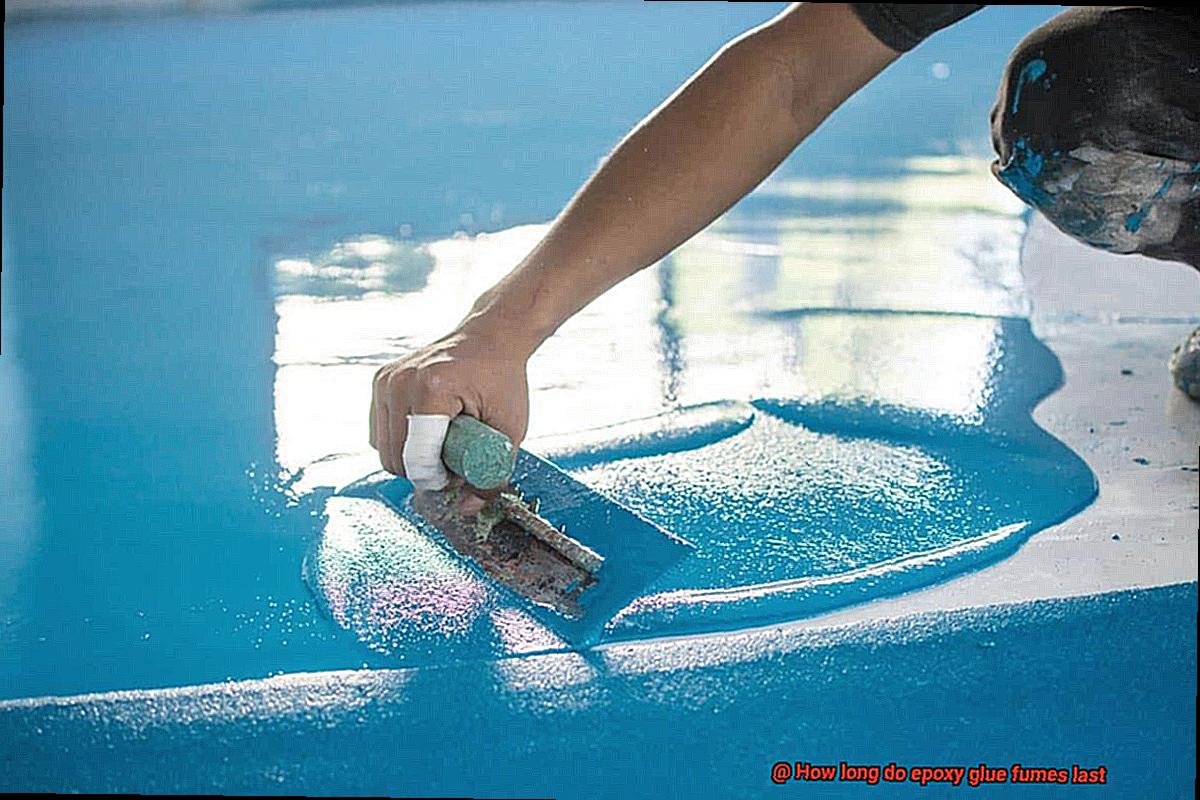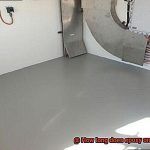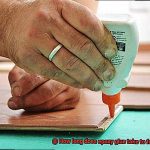Have you ever completed a DIY project and basked in the glow of accomplishment, only to be quickly brought back down to earth by the overpowering stench of epoxy glue fumes? If so, you’re not alone. The pungent odor of epoxy glue can linger for what feels like an eternity, leaving you wondering just how long those fumes will stick around and what kind of risks they pose.
In this blog post, we’ll dive headfirst into the world of epoxy glue fumes and answer all your burning questions. How long do those pesky odors last? What are the potential health hazards associated with exposure? And most importantly, what can you do to minimize your risk?
We’ll take a deep dive into the science behind epoxy glue, exploring the chemical reactions that produce those potent fumes and shedding light on their potential impact on your respiratory system. Whether you’re a seasoned DIY pro or just starting out on your home improvement journey, this article is a must-read.
So buckle up and join us as we embark on a scientific adventure through the world of epoxy glue fumes. We’ll uncover everything you need to know to stay safe and healthy while working with this powerful adhesive, all while keeping things casual, informative, and personal.
What is Epoxy Glue?
Contents
Epoxy glue is a two-component adhesive that consists of a resin and a hardener. When mixed in the right proportions, it forms a robust and durable bond that can join various materials such as metals, plastics, ceramics, and wood. Its versatility makes it an excellent choice for DIY projects, repairing objects, or building something from scratch.

The thick consistency of epoxy glue allows it to fill gaps and cracks in surfaces, making it ideal for situations where a tight seal is required, such as plumbing or automotive repairs. Its strength and durability also make it a popular choice for industrial and construction projects.
However, the release of harmful fumes when using epoxy glue should not be taken lightly. Proper ventilation is essential to reduce the duration of exposure to these fumes. Open windows and doors or use a fan to blow air out of the room. Wearing gloves and a mask can also minimize the risk of exposure.
To ensure successful projects and long-lasting bonds, it’s crucial to follow the manufacturer’s instructions carefully when using epoxy glue. Failure to do so can result in a weak bond or other issues with the finished product. Understanding its properties and proper usage can help achieve a secure bond.
How Long Do Epoxy Glue Fumes Last?
Epoxy glue is a versatile adhesive that’s used in various industries ranging from construction to woodworking. It’s known for its strength and durability. However, it’s important to handle it with care because of the harmful fumes it produces. This brings us to the question – how long do epoxy glue fumes last and what are the risks associated with them?
The duration of epoxy glue fumes depends on several factors, such as the type of epoxy used, the amount applied, and ventilation in the area. Typically, epoxy glue takes about 24-48 hours to cure and stop emitting fumes. However, the intensity of these fumes can vary during this time period.
It’s crucial to note that inhaling epoxy fumes can cause respiratory problems, headaches, and dizziness. Prolonged exposure can lead to severe health issues like lung damage or cancer. Therefore, it’s essential to use epoxy glue in a well-ventilated area and wear protective gear such as gloves and a mask.
To minimize the risk of exposure to epoxy fumes, there are a few things you can do. Firstly, avoid using it in confined spaces or areas without proper ventilation. Secondly, dispose of any leftover epoxy glue properly and don’t pour it down the drain or throw it in the trash. Thirdly, follow the manufacturer’s instructions when using epoxy glue.
In conclusion, while epoxy glue is an excellent adhesive that can bond various materials together strongly and durably, it’s essential to handle it with care and take necessary precautions when using it. The duration of its fumes varies depending on several factors. But irrespective of how long they last, ensure proper ventilation and wear protective gear to minimize any potential health risks associated with its use.
Factors Affecting the Duration of Epoxy Glue Fumes
Epoxy glue is a popular adhesive that is used to bond materials in various industries. However, it emits harmful fumes that can cause severe health issues if inhaled in large quantities. As an expert on this topic, I have researched and compiled a list of factors that affect how long epoxy glue fumes last.
The type of epoxy glue being used is a crucial factor that affects how long the fumes last. One-part epoxy glues dry quickly and emit fewer fumes, while two-part epoxy glues take longer to dry and emit more fumes. Therefore, two-part epoxy glues will have longer-lasting fumes than one-part epoxy glues. It’s important to consider the type of epoxy glue being used when determining how long the fumes will last.
Temperature and humidity levels of the environment also play a significant role in how long epoxy glue fumes last. Higher temperatures and humidity levels can speed up the curing process of the glue, resulting in shorter fume durations. On the other hand, lower temperatures and humidity levels slow down the curing process, leading to longer fume durations. It’s essential to consider the environmental temperature and humidity levels when working with epoxy glue.
Ventilation is another crucial factor that affects how long epoxy glue fumes last. Adequate ventilation helps to disperse the fumes quickly, reducing their duration. Conversely, poor ventilation traps the fumes in the air, leading to longer-lasting fumes. It’s important to ensure that there is proper ventilation when working with epoxy glue.
Personal factors such as sensitivity to chemicals, age, and health status can also affect how long epoxy glue fumes last. Individuals who are sensitive to chemicals or have pre-existing respiratory conditions may experience longer-lasting fumes than those who are not sensitive or have no respiratory issues. Additionally, older people may experience longer-lasting fumes due to their decreased lung capacity. It’s crucial to consider personal factors when working with epoxy glue.
The Health Risks of Inhaling Epoxy Glue Fumes
While it can be a game-changer for various projects, it’s crucial to understand the potential dangers that come along with inhaling its fumes. Inhaling the fumes released by epoxy glue can pose serious health risks. These fumes are a result of the chemical reaction between the two-part epoxy resin and hardener, and they can cause respiratory irritation, headaches, dizziness, and nausea. Prolonged exposure to these fumes can also lead to more severe health problems such as asthma, bronchitis, and even lung cancer.
To avoid these health risks, it’s important to take necessary precautions when working with epoxy glue. Here are some tips:
- Wear protective gear: Gloves, goggles, and a respirator mask are essential protective gear that will help reduce your exposure to fumes. They will also protect your skin and eyes from contact with the adhesive.
- Ensure proper ventilation: Adequate airflow is crucial when working with epoxy glue. Open windows or use a fan to help circulate the air and keep the fumes from accumulating in one area.
- Limit exposure time: Working in short intervals when using epoxy glue is best. Take frequent breaks to step outside and get some fresh air.
- Store epoxy glue properly: Always follow the manufacturer’s instructions on how to store your epoxy glue. Improper storage can lead to increased fume release and deterioration of the adhesive.
It’s important to note that the severity of health risks associated with inhaling epoxy glue fumes depends on several factors such as duration of exposure, concentration of fumes in the air, and individual sensitivity to chemicals. Therefore, taking necessary precautions is crucial to avoiding prolonged exposure and minimizing risks.
Safety Precautions to Consider When Using Epoxy Glue
When it comes to using epoxy glue, safety should be your top priority. Epoxy glue is a two-part adhesive made up of resin and hardener, which creates a strong bond when mixed together. However, the mixing and curing process can release harmful fumes into the air, making safety precautions crucial.
To ensure your safety, always read and follow the manufacturer’s instructions carefully. This includes wearing proper protective gear such as gloves, goggles, and a respirator mask. These items will protect you from inhaling harmful fumes and prevent skin contact.
When using epoxy glue, it’s important to work in a well-ventilated area to minimize exposure to fumes. Open windows and doors or use a fan to increase air circulation. This simple step can help reduce the risk of inhaling harmful fumes.
Direct skin contact with epoxy glue can cause skin irritation or allergic reactions, so it’s essential to avoid it at all costs. If skin contact occurs, wash the affected area with soap and water immediately.
Epoxy glue should be kept out of reach of children and pets since it’s toxic if ingested. Store it in a cool and dry place away from direct sunlight to prevent it from curing prematurely.
Reducing the Duration of Epoxy Glue Fumes
These fumes can be not only irritating but also harmful to your health, making it essential to take necessary precautions. In this passage, I will provide you with insights on how to reduce the duration of epoxy glue fumes and create a safer working environment.
Proper ventilation is crucial when working with epoxy glue. By opening windows and doors, using fans, or working in an open area with fresh air, you can improve air circulation and reduce the duration of fumes. Additionally, wearing a mask or respirator designed for fumes will further protect you from inhaling harmful chemicals.
Another effective way to reduce the duration of fumes is by choosing low-odor or odorless epoxy glue products. These products emit fewer fumes and have a faster curing time, reducing exposure time to harmful chemicals. When purchasing any epoxy glue product, read the label carefully to ensure you choose a low-odor or odorless product.
Cleaning up excess epoxy glue immediately after use can also help minimize the duration of fumes in your workspace. Any uncured epoxy should be wiped away with a damp cloth or paper towel, and any tools used should be cleaned thoroughly with soap and water.
To summarize, here are some key steps to take to reduce the duration of epoxy glue fumes:
- Ensure proper ventilation during and after application
- Wear a mask or respirator designed for fumes
- Choose low-odor or odorless epoxy glue products
- Clean up excess glue immediately after use
Conclusion
In conclusion, epoxy glue is a powerful adhesive that can effectively bond various materials together. However, its fumes should not be underestimated, as they can cause severe health issues if inhaled. The duration of epoxy glue fumes depends on several factors, including the type of epoxy used, the amount applied, and the ventilation in the area.
Typically, it takes about 24-48 hours for epoxy glue to cure and stop emitting harmful fumes. However, this timeline can vary depending on individual factors such as temperature and humidity levels in the workspace.
It’s crucial to wear protective gear such as gloves and a mask when working with epoxy glue. Inhaling its fumes can lead to respiratory problems, headaches, dizziness, and even long-term lung damage or cancer.
To minimize exposure time to harmful chemicals, it’s recommended to use low-odor or odorless products when possible. Additionally, proper ventilation during and after application is essential to reduce the duration of epoxy glue fumes.
Cleaning up excess glue immediately after use is another effective way to minimize the duration of fumes in your workspace.






